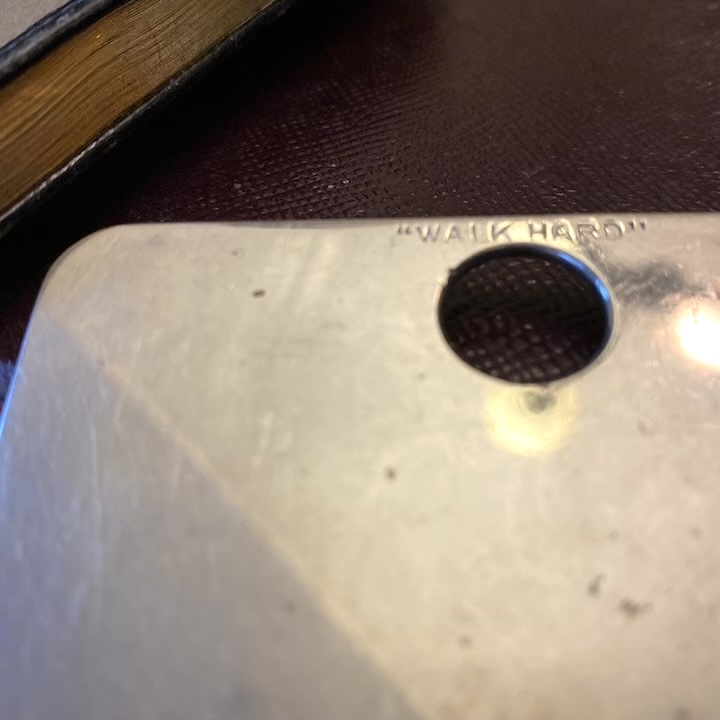
A MIRROR Made in the USA?
When my brother packed up Uncle George’s WWI signal mirror in its archival biscuit tin and took it to Chicago, I knew that I wanted to make a new set of mirrors. Just having George’s mirror in my hand, feeling its gravity and smooth surface, and seeing its beautiful patina was inspiring. The object is deceivingly simple–it’s just a piece of metal, right? I didn’t think it would be hard to get a few of these made. However, as a naturalist whose hobbies never alighted on metalwork, I had no idea what I was in for.
Away Offshore
Given our Company’s commitment to exhaust all avenues of local manufacturing, I did not even consider foreign options. It would have been cheaper for sure. An offshore solution could have set up a pipeline where I could have a quick turnaround for larger numbers of mirrors. But I quite literally did not care about these things. While in our current economy it is not practical to be completely opposed to foreign manufacturing, it is possible to focus on having as much of your manufacturing take place as locally as possible.
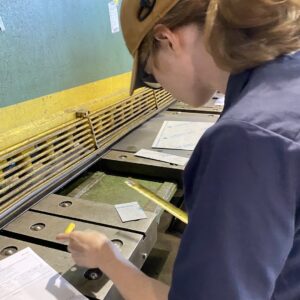
Cutting a test mirror
Making the Cut
The first option I considered for making the mirrors was to cut the metal mirrors myself. Looking back with the knowledge I have now, I realize that it would have been nice to spare myself the trip down this rabbit hole. It turns out this wasn’t a realistic option given that thick metal is hard to cut, messy, and extremely time consuming to polish.
Once I figured out that I needed a partner, I started calling around and found a metal warehouse that would entertain a visit. I entered the small shop and explained what must have seemed like a harebrained scheme to the technician. He pulled a sheet of thick metal out of a vertical rack and took it to the cutting machine. Once he had a square of metal cut the size of the mirror, he took it over to a drill press and started to bore a ½ inch hole in the plate. It was time consuming, and a bit loud, but it eventually broke through. Last, he took the mirror over to the grinder and rounded the edges. It was a great first try.
I then took the crude mirror home and used some buffing wheels and polishing compounds I had ordered to try to polish it. As a fairly experienced woodworker, I recognized the feeling when a sanding or polishing process I’m applying is not up to the task. I needed to find an industrial partner willing to deal with an upstart business who could cut and then polish my mirrors.
Thankfully, I live in Minneapolis. Given that there is still a large capacity for manufacturing in the city, I was able to identify a set of companies that do metalwork. I stopped over to Coremark Metals in the Hawthorne neighborhood of North Minneapolis. I walked into the main lobby and started walking around and curiously investigated the characteristic yellow shelves and portals that lodged metals of all shapes and sizes. There was brass and iron and aluminum. There were blocks and metal dowels and sheets and square rods.
I was fascinated, inspired, and looked out of my depth. The people around were focused and were clearly serious workers who knew what they wanted. I wandered and perused. Finally, an employee approached me and asked me how he could help. I had become more comfortable with trying to explain that I had this great grand uncle who was a WWI veteran who passed down a signal mirror that I wanted to recreate. Thankfully, he seemed interested, and said that I needed to talk to a project manager, and he gave me a contact.
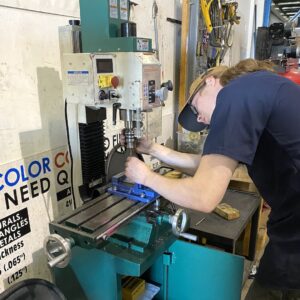
Drilling Hole in Test Mirror
I eventually slipped out, not appearing burly, but having a bit more of an upright presence than when I had arrived. That afternoon I reached out to the project manager and he was incredibly efficient. He helped me identify the appropriate steel and told me how to create the proper measurements. Once I passed those on to him, he drafted the design that they would cut, the hole size, and gave me the price. I knew already that trying to get the attention of manufacturers for small runs could be next to impossible. He was unphased by my relatively low number of mirrors (one hundred to start), and I was relieved. I paid, and a week later the mirrors were cut. I returned to Hawthorne and went outside to the loading dock and picked up my precisely cut, but relatively rough, signal mirror templates.
The #8 Polish
It turns out that metal workers have their own taxonomy of shininess. As I considered my failed attempt to personally polish a metal surface to a mirror shine, I began to explore this lexicon of reflectivity. I learned I was starting with a #3, a course and roughly ground surface. Moving up from there, increasing level of polish moves through #4, an “architectural finish,” #5 a “dairy finish” for industrial uses, and then three levels of finer finishes that end with #8. The #8 is what I wanted–a mirror finish. Now I just needed to find out how to get it.
Luckily there is a giant warehouse in St. Paul that houses AAA Metal Finishing. Additional fortune provided that Junior, the manager and polishing expert, was there when I arrived. A relatively small business with very big machines, Junior enthusiastically helped me understand the possibilities for polishing the mirrors, and said that they would make me a sample with a #8 surface. It was a very labor intensive process to individually polish both sides of the mirror, and chamfer the hole, and it would clearly be the most expensive single aspect of the mirror and case. But when I got the sample it was also clear it would be worth it.
I didn’t need to examine the sample for more than a minute before I let Junior know it was a go. It was as simple as that and in a few weeks I picked up a set of 100 mirrors, each individually polished and carefully wrapped in a soft and thick paper material that had the appearance of a red Oxford cloth. The mirrors were beautiful and just as I had hoped.
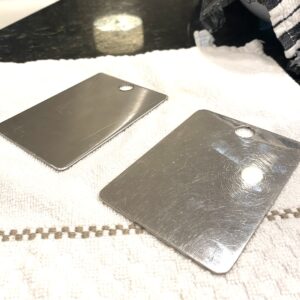
Original Signal Mirror and Test Mirror
There is value imbued into an inanimate object by people working together, in person, to create it. There is quality that comes from hands working cutters, grinders, sanders, sewing machines, and leather cutters to eventually create a product that they can see, be proud of, and hand off to their client. When I looked at the small series of miniscule parallel threadlines on our mirrors that revealed the polishing process, I saw this quality and value. It was direct evidence of the efforts of individuals.
Making the Marks
The last step of manufacturing the mirror itself was stamping the blank with the slogan, the company name, and a unique serial number. This part of the process was all completed in the Dogwatch Studio, less than 15 miles from both of our other partners.
The first step in the stamping process was to order custom stamps. In order to put an exact stamp into a #8 polish it is necessary to have a very good stamp cut. It turns out there is a learning curve to how big the letters will appear, and despite the investment into each metal stamping tool, trials needed to be done to get the desired result.
The top of the original signal mirror from Uncle George’s 228th Fusiliers mirror was “WALK HARD” (quotation marks original to the mirror). I initially wondered whether we might use that on our mirrors, but ultimately decided to use it as an inspiration rather than a template for two reasons.
First, I had not been able to determine anything about the origin of the “walk hard” text. It was possible that it had meaning and significance to that regiment, and despite the fact that all members were surely no longer living, it did not seem respectful to co opt a possibly reverential mantra without understanding the context. The second reason was more practical. It turns out there was a recent motion picture named “Walk Hard,” that starred John C. Reilly, and which applied a–how to say–connotation unbecoming to modern interpretation of a “walk hard” slogan. I thought of trying to bring my concerns to Reilly, who is a friend of a friend, or maybe a friend of a friend of a friend, but decided against it. But if you are out there Mr. Reilly, I’d love to talk with you about this issue, and I actually think you might like our mirrors. In spite of these features, and the related diversion, I decided on a related pair of words.
Being a naturalist and scientist, a toe-dipping transcendentalist, and having regularly channeled the musings on observation of many historical figures–Carl Linneaus, John Burroughs, Theodore Roosevelt, to name a few–I decided that the multifaceted “LOOK HARD” would be an appropriate mantra for our mirrors. We look within and without for meaning and inspiration.
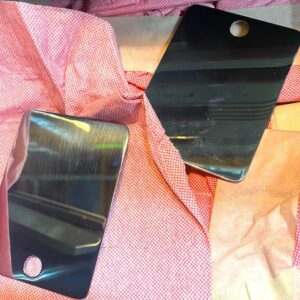
Polished mirror blanks
Cutting a Jig
The last step to stamp and complete the production of the mirrors themselves was to find a way to stamp the metal in a consistent location. This was most important for the stamp above the hole, as the tolerance is relatively small for movement up or down. I decided to build a custom jig, and my first stop was back at Coremark Metals.
The base of the jig is a slab of ¾ thick steel, 18 inches square. I picked this up at Coremark, and it is an understatement to say that it is solid. It provides a great base for stamping, and I then cut and chiseled out an MDF template and holes for the metal stamps to fit in a relatively precise location on the mirror. Given that each number is sequential, I rigged a series of wooden blanks so that I could move the individual digits from left to right and have them spaced closer together than the numbers would appear if the stamps were placed directly next to one another.
Once the jig was complete, it was simply time to get a cup of coffee and carefully focus on each blank so that the numbers found their way into the correct position. With that, the first facets of the patina on the mirror surface were made. They patiently await company from marks and scratches that will come with the adventures of their future owners.